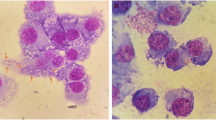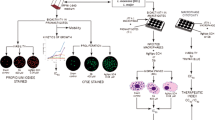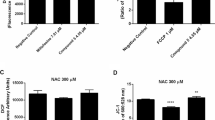Abstract
Purpose
Today, the use of natural products and nanostructures has increased. Given the reports on beneficial effects of various organotellurane compounds on types of visceral leishmaniasis, we decided to investigate the effect of TeO2 NPs on Leishmania major (L. major). Tellurium can cause cell apoptosis in cancer cells without activating the caspase-pathway.
Methods
TeO2 NPs at first synthesized and the structure was checked by XRD, SEM and EDS tests. The cytotoxic effect of TeO2 NPs against L. major promastigotes, amastigotes and macrophages was assessed by MTT test or counting. The possible apoptosis of L. major by TeO2 NPs was evaluated by flow cytometry test. For in vivo assay, the lesions of infected BALB/c mice with L. major promastigotes were treated with TeO2 NPs, then the lesion size and survival rate were evaluated.
Results
The synthesis of TeO2 with tetragonal structure was confirmed by XRD. The combination of nanorods and nanoflakes and the presence of Te were proven by SEM and EDS, respectively. According the effects of nanoparticle on promastigotes and amastigotes, the IC50 values of TeO2 after 72 h of incubation were 15.13 and 52.22 µg/ml, respectively. TeO2 NPs induced apoptosis in about 41% of promastigotes. The ulcer greatly healed and survival rate was higher in treated mice compared to those in control group.
Conclusion
Based on the data, favorable anti-leishmanial properties were observed by using TeO2 NPs. TeO2 NPs have cytotoxic impacts on L. major promastigotes and amastigotes in vitro and in vivo and may be regarded as a therapy option.








Similar content being viewed by others
References
Gutierrez V, Seabra AB, Reguera RM, Khandare J, Calderón M (2016) New approaches from nanomedicine for treating leishmaniasis. Chem Soc Rev 45(1):152–168. https://doi.org/10.1039/c5cs00674k
Nagle AS, Khare S, Kumar AB, Supek F, Buchynskyy A, Mathison CJ, Chennamanen NK, Pendem N, Buckner FS, Gelb MH, Molteni V (2014) Recent developments in drug discovery for leishmaniasis and human African trypanosomiasis. Chem Rev 114(22):11305–11347. https://doi.org/10.1021/cr500365f
Alvar J, Velez ID, Bern C, Herrero M, Desjeux P, Cano J, Jannin J, Boer M (2012) Leishmaniasis worldwide and global estimates of its incidence. PLoS ONE 7(5):35671. https://doi.org/10.1371/journal.pone.0035671
Oryan A, Akbari M (2016) Worldwide risk factors in leishmaniasis. Asian Pac J Trop 9(10):925–932. https://doi.org/10.1016/j.apjtm
Shokri A, Abastabar M, Keighobadi M, Emami S, Fakhar M, Teshnizi SH, Makimura K, Rezaei-Matehkolaei A, Mirzaei H (2018) Promising antileishmanial activity of novel imidazole antifungal drug Luliconazole against Leishmania major: in vitro and in silico studies. J Glob Antimicrob Resist 14:260–265. https://doi.org/10.1016/j.jgar
Lamour SD, Veselkov KA, Posma JM, Giraud E, Rogers ME, Croft S, Marchesi JR, Holmes E, Seifert K, Saric J (2014) Metabolic, immune, and gut microbial signals mount a systems response to Leishmania major infection. J Proteome Res 14(1):318–329. https://doi.org/10.1021/pr5008202
Croft SL, Seifert K, Yardley V (2006) Current scenario of drug development for leishmaniasis. Indian J Med Res 123(3):399–410
Sundar S, More DK, Singh MK, Singh VP, Sharma S, Makharia A, Kumar PC, Murray HW (2000) Failure of pentavalent antimony in visceral leishmaniasis in India: report from the center of the Indian epidemic. Clin Infect Dis 31(4):1104–1107. https://doi.org/10.1086/318121
Akbari M, Oryan A, Hatam G (2017) Application of nanotechnology in treatment of leishmaniasis: a review. Acta Trop 172:86–90. https://doi.org/10.1016/j.actatropica.2017.04.029
Soosaraei M, Fakhar M, Teshnizi SH, Hezarjaribi HZ, Banimostafavi ES (2017) Medicinal plants with promising antileishmanial activity in Iran: a systematic review and meta-analysis. Ann Med Surg 21:63–80. https://doi.org/10.1016/j.amsu.2017.07.057
Dolat E, Rajabi O, Salarabadi SS, Yadegari-Dehkordi S, Sazgarnia A (2015) Silver nanoparticles and electroporation: their combinational effect on leishmania major. Bioelectromagnetics 36(8):586–596. https://doi.org/10.1002/bem.21945
Jebali A, Kazemi B (2013) Nano-based antileishmanial agents: a toxicological study on nanoparticles for future treatment of cutaneous leishmaniasis. Toxicol In Vitro 27(6):1896–1904. https://doi.org/10.1016/j.tiv.2013.06.002
Beheshti N, Soflaei S, Shakibaie M, Yazdi MH, Ghaffarifar F, Dalimi A, Shahverdi AR (2013) Efficacy of biogenic selenium nanoparticles against Leishmania major: in vitro and in vivo studies. J Trace Elem Med Biol 27(3):203–207. https://doi.org/10.1016/j.jtemb.2012.11.002
Cunha RL, Gouvea IE, Juliano L (2009) A glimpse on biological activities of tellurium compounds. An Acad Bras Cienc 81(3):393–407. https://doi.org/10.1590/s0001-37652009000300006
Yu F, Li P, Wang B, Han K (2013) Reversible near-infrared fluorescent probe introducing tellurium to mimetic glutathione peroxidase for monitoring the redox cycles between peroxynitrite and glutathione in vivo. J Am Chem Soc 135(20):7674–7680. https://doi.org/10.1021/ja401360a
Lutz V, Mannchen F, Krebs M, Park N, Krüger C, Raja A, Sasse F, Baro A, Laschat S (2014) SAR studies on hydropentalene derivatives—important core units of biologically active tetramic acid macrolactams and ptychanolides. Bioorg Med Chem 22(13):3252–3261. https://doi.org/10.1016/j.bmc.2014.04.063
Zakrzewski J, Huras B, Kiełczewska A, Krawczyk M (2016) Reactions of nitroxides 16. First nitroxides containing tellurium atom. RSC Adv 6(101):98829–98834. https://doi.org/10.1039/C6RA15880C
Engman L, Al-Maharik N, McNaughton M, Birmingham A, Powis G (2003) Thioredoxin reductase and cancer cell growth inhibition by organotellurium antioxidants. Anticancer Drugs 14(2):153–161. https://doi.org/10.1097/00001813-200302000-00009
Doering M, Diesel B, Gruhlke MC, Viswanathan UM, Mániková D, Chovanec M, Burkholz T, Slusarenko AJ, Kiemer AK, Jacob C (2012) Selenium-and tellurium-containing redox modulators with distinct activity against macrophages: possible implications for the treatment of inflammatory diseases. Tetrahedron 68(51):10577–10585. https://doi.org/10.1002/chem.201000884
Bandeira PT, JoPA S, DbB S, Garcia FP, Nakamura CV, de Oliveira AR, Piovan L (2019) Diacetal ditellurides as highly active and selective antiparasitic agents toward Leishmania amazonensis. ACS Med Chem Lett. https://doi.org/10.1021/acsmedchemlett.9b00060
Murray HW (2001) Clinical and experimental advances in treatment of visceral leishmaniasis. Antimicrob Agents Chemother 45(8):2185–2197. https://doi.org/10.1128/AAC.45.8.2185-2197.2001
Seifert K (2011) Structures, targets and recent approaches in anti-leishmanial drug discovery and development. Open J Med Chem 5:31. https://doi.org/10.2174/1874104501105010031
Sen R, Chatterjee M (2011) Plant derived therapeutics for the treatment of Leishmaniasis. Phytomedicine 18(12):1056–1069. https://doi.org/10.1016/j.phymed.2011.03.004
Tempone AG, de Oliveira CM, Berlinck RG (2011) Current approaches to discover marine antileishmanial natural products. Planta Med 77(06):572–585. https://doi.org/10.1055/s-0030-1250663
Tiuman TS, Santos AO, Ueda-Nakamura T, Dias Filho BP, Nakamura CV (2011) Recent advances in leishmaniasis treatment. Int J Infect Dis 15(8):e525–e532. https://doi.org/10.1016/j.ijid.2011.03.021
Abazari R, Mahjoub AR, Molaie S, Ghaffarifar F, Ghasemi E, Slawin AM, Carpenter-Warren C (2018) The effect of different parameters under ultrasound irradiation for synthesis of new nanostructured Fe3O4@ bio-MOF as an efficient anti-leishmanial in vitro and in vivo conditions. Ultrason Sonochem 43:248–261. https://doi.org/10.1016/j.ultsonch.2018.01.022
Tavakoli P, Ghaffarifar F, Delavari H, Shahpari N (2019) Efficacy of manganese oxide (Mn2O3) nanoparticles against Leishmania major in vitro and in vivo. J Trace Elem Med Biol. https://doi.org/10.1016/j.jtemb.2019.08.003
Khademvatan S, Eskandari K, Hazrati-Tappeh K, Rahim F, Foroutan M, Yousefi E, Asadi N (2019) In silico and in vitro comparative activity of green tea components against Leishmania infantum. J Glob Antimicrob Resist. https://doi.org/10.1016/j.jgar.2019.02.008
Nogueira CW, Zeni G, Rocha JB (2004) Organoselenium and organotellurium compounds: toxicology and pharmacology. Chem Rev 104(12):6255–6286. https://doi.org/10.1021/cr0406559
Chasteen TG, Bentley R (2003) Biomethylation of selenium and tellurium: microorganisms and plants. Chem Rev 103(1):1–26. https://doi.org/10.1021/cr010210+
Abondanza T, Oliveira C, Barbosa C, Pereira F, Cunha RLOR, Caires A, Comasseto JV, Queiroz ML, Valadares MC, Bincoletto C (2008) Bcl-2 expression and apoptosis induction in human HL60 leukaemic cells treated with a novel organotellurium (IV) compound RT-04. Food Chem Toxicol 46(7):2540–2545. https://doi.org/10.1016/j.fct.2008.04.010
Sredni-Kenigsbuch D, Shohat M, Shohat B, Ben-Amitai D, Chan C-C, David M (2008) The novel tellurium immunomodulator AS101 inhibits interleukin-10 production and p38 MAPK expression in atopic dermatitis. J Dermatol Sci 50(3):232–235. https://doi.org/10.1016/j.jdermsci.2007.12.007
Cunha RL, Urano ME, Chagas JR, Almeida PC, Bincoletto C, Tersariol IL, Comasseto JV (2005) Tellurium-based cysteine protease inhibitors: evaluation of novel organotellurium (IV) compounds as inhibitors of human cathepsin B. Bioorg Med Chem Lett 15(3):755–760. https://doi.org/10.1016/j.bmcl.2004.11.012
Shakibaie M, Abharian A, Forootanfar H, Ameri A, Jafari M, Rahimi HR (2018) Cytotoxicity investigations of biogenic tellurium nanorods towards PC12 cell line. IET Nanobiotechnol 12(8):1144–1149. https://doi.org/10.1049/iet-nbt.2018.5137
Lima CBC, Arrais-Silva WW, Cunha RLOR, Giorgio S (2009) A novel organotellurium compound (RT-01) as a new antileishmanial agent. Korean J Parasitol 47(3):213. https://doi.org/10.3347/kjp.2009.47.3.213
Pimentel IAS, de Siqueira PC, Katz S, de Souza Júdice WA, Cunha RL, Barbieri CL (2012) In vitro and in vivo activity of an organic tellurium compound on Leishmania (Leishmania) chagasi. PLoS ONE 7(11):e48780. https://doi.org/10.1371/journal.pone.0048780
Dalimi A, Delavari M, Ghaffarifar F, Sadraei J (2015) In vitro and in vivo antileishmanial effects of aloe-emodin on Leishmania major. J Tradit Complement Med 5(2):96–99. https://doi.org/10.1016/j.jtcme.2014.11.004
Bhatti QA, Baloch MK, Schwarz S, Petzold G (2014) Effect of various parameters on the stability of silica dispersions. J Solut Chem 43(11):1916–1928. https://doi.org/10.1007/s10953-014-0260-6
Qin B, Bai Y, Zhou Y, Liu J, Xie X, Zheng W (2009) Structure and characterization of TeO2 nanoparticles prepared in acid medium. Mater Lett 63(22):1949–1951. https://doi.org/10.1016/j.matlet.2009.06.018
Acknowledgements
The authors would like to appreciate the financial support of Tarbiat Modares University—Iran. This article was an outcome of an MSc thesis undertaken by Pooya Tavakoli, MSc student in Medical Parasitology.
Author information
Authors and Affiliations
Contributions
PT and FG and HD conceived the study; HD designed and analyzed the synthesis of TeO2 NPs. FG designed the study protocol; FG was supervisor of this research; HD was advisor of the research; PT drafted the manuscript; VN, PT, HD, AK and FG critically revised the manuscript. MS Dayer contributed to the drafting and revision of manuscript.
Corresponding author
Ethics declarations
Conflict of interest
The authors declared no potential conflicts of interest with respect to the research, authorship, and/or publication of this article.
Ethics approval
This research was approved by ethical committee of Tarbiat Modares University with number IRMODARES.REC 1397-177; 5-Jan-2019.
Additional information
Publisher's Note
Springer Nature remains neutral with regard to jurisdictional claims in published maps and institutional affiliations.
Rights and permissions
About this article
Cite this article
Tavakoli, P., Ghaffarifar, F., Delavari, H. et al. Synthesis of Tellurium Oxide (TeO2) Nanorods and Nanoflakes and Evaluation of Its Efficacy Against Leishmania major In Vitro and In Vivo. Acta Parasit. 67, 143–152 (2022). https://doi.org/10.1007/s11686-021-00445-w
Received:
Accepted:
Published:
Issue Date:
DOI: https://doi.org/10.1007/s11686-021-00445-w




